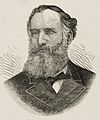New South Wales colonial election, 1887
|
|
|||||||||||||||||||||||||
|---|---|---|---|---|---|---|---|---|---|---|---|---|---|---|---|---|---|---|---|---|---|---|---|---|---|
|
|||||||||||||||||||||||||
|
All 124 seats in the New South Wales Legislative Assembly 63 Assembly seats were needed for a majority |
|||||||||||||||||||||||||
|
|||||||||||||||||||||||||

Legislative Assembly after the election
|
|||||||||||||||||||||||||
|
|||||||||||||||||||||||||
The 1887 New South Wales colonial election was held between 4 February and 26 February 1887. This election was for all of the 124 seats in the New South Wales Legislative Assembly and it was conducted in 37 single-member constituencies, 23 2-member constituencies, seven 3-member constituencies and five 4-member constituencies, all with a first past the post system. Suffrage was limited to adult white males. The previous parliament of New South Wales was dissolved on 26 January 1887 by the Governor, Lord Carrington, on the advice of the Premier, Sir Henry Parkes.
Parkes had defeated the government of Patrick Jennings less than a week previously, and was keen to test his electoral strength. This was the first election at which there were recognisable political parties, namely the Protectionist Party, which coalesced around Jennings' successor George Dibbs, and Parkes' Free Trade Party. At this stage these parties were still organisationally very different from today's political parties, and party affiliation was often fluid or non-existent, depending on the individual member.
New South Wales colonial election, 4 – 26 February 1887
Legislative Assembly
<< 1885 — 1889 >>
...
Wikipedia


